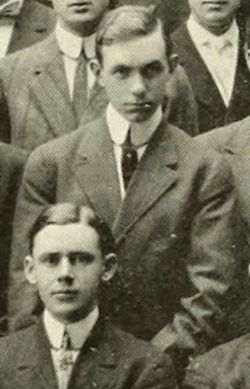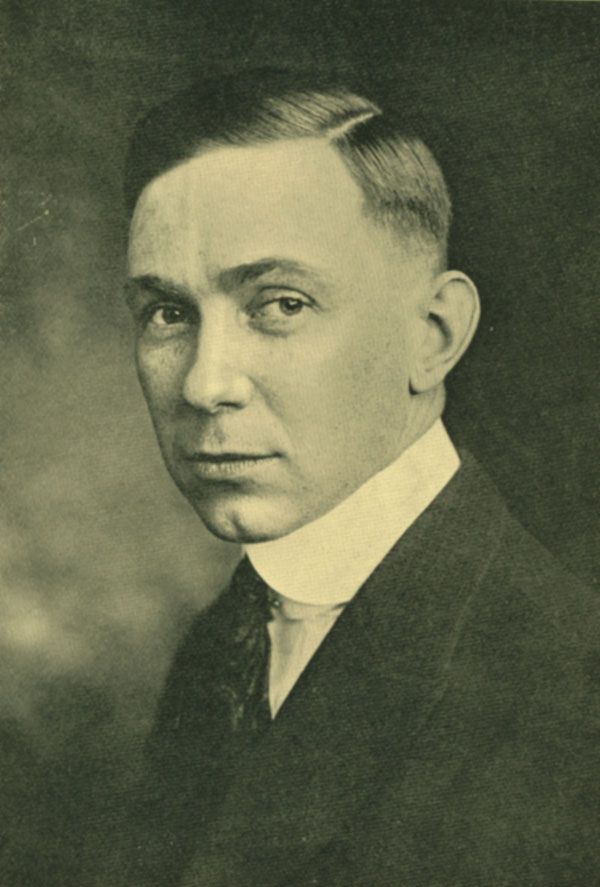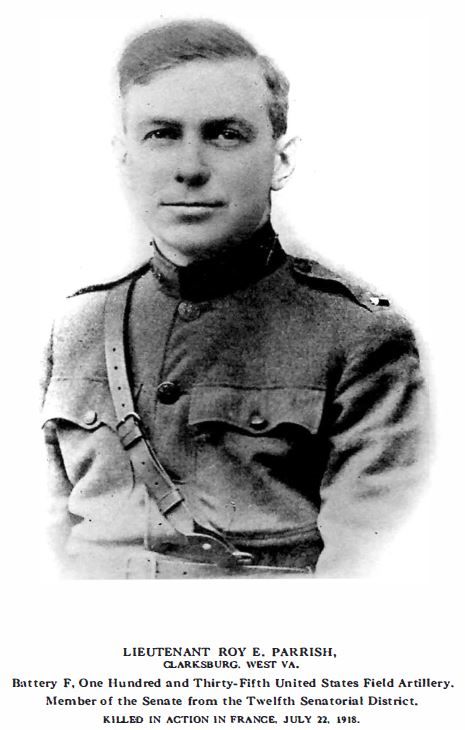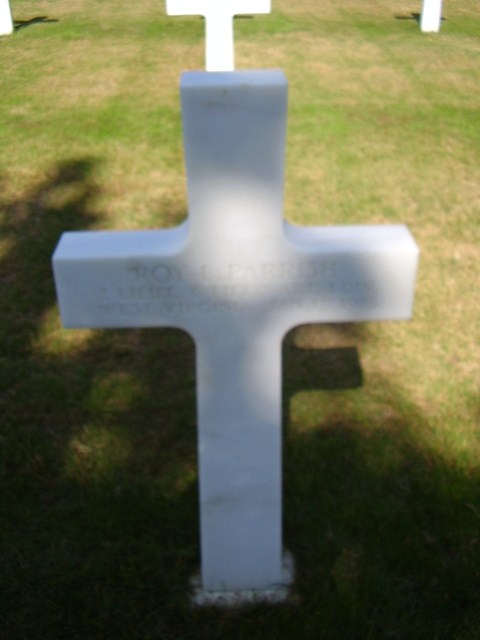Roy Parrish (126054039)
West Virginia, Special Limited Edition (1922), pp. 109-111:
[Roy Earl Parrish
OF the Gold Stars set in West Virginia's honor roll of soldier dead in the great war, one represents Roy Earl Parrish, a son of Thomas Jefferson Parrish, the Clarksburg business man and banker. He left a secure place in his profession and the honors of politics and public office to become a soldier, and in that new and strange role, until his death, he expressed, as the tributes of his superiors and comrades testified, some of the most noteworthy characteristics of the American soldier.
A son of Thomas J. and Mary (Morgan) Parrish, he was born at Wallace, Harrison County, November 27, 1888. He was educated in the public schools, graduated from West Virginia Wesleyan College, studied law in West Virginia University, was admitted to the bar at Clarksburg in 1910, and was engaged in practice until he went into the army. In 1912 he was elected to the House of Delegates, serving through the session of 1913, and in 1914 was elected to the State Senate by a large majority from the Twelfth Senatorial District. He was vice-chairman of the Republican State Committee for the first Congressional District, and was chairman of the Republican County Executive Committee of Harrison County. He was a member of the Sigma Chi fraternity and the Clarksburg University Club.
So much for the dire statistics of his life. For the significance of his character and the service he rendered as a civilian and as a soldier a deft record is found in the proceedings of the State Senate for January 21, 1919, a day set apart by formal motion for memorial services in honor of Lieutenant Parrish. From the proceedings of that day it is possible here to quote a portion of only one address, that delivered by his successor in the Senate from the Twelfth District, Harvey W. Harmer, a life-long friend of Lieutenant Parrish. Senator Harmer, after reviewing his boyhood, his continued interest in his church, the First Methodist Episcopal of Clarksburg, his graduation in 1908 from the Wesleyan College at Buckhannon, the graduation from the University Law School in 1910, his active practice as a member of the Clarksburg bar and the unusual influence he exercised as one of the youngest members of the House of Delegates and the State Senate, took up his patriotic record, and what he said on that point may properly stand as the permanent tribute to this brave young West Virginia officer. The concluding paragraphs of Senator Harmer's address are as follows:
''Largely because of the conditions growing out of our entering into the great World war, the Governor of our State called the members of the legislature to assemble here in a second extraordinary session on the fourteenth of May, 1917. Instead of heeding this call of the Governor, instead of seeking the pleasure of your association in legislative work, ROY PARRISH chose to volunteer as a soldier in the American Army, and on the day you assembled here, he entered Fort Benjamin Harrison, at Indianapolis, Indiana, in the training school for officers. In that school he remained until August 15th, when he was commissioned Second Lieutenant of Field Artillery.
"After a few days at home he reported to Camp Sherman, Chillicothe, Ohio, on September first, and eight days later he was transferred to Camp Sheridan, Montgomery, Alabama. Shortly after his arrival at Camp Sheridan, his ability as a soldier and lawyer was recognized and he was made Assistant Judge Advocate, a position he filled until November 15. On November 20, 1917, he was detailed as Judge Advocate and served in that capacity until ordered to prepare for duty overseas. He left Camp Sheridan December 15th, with orders to report in New York City on January 2d, 1918. In the few intervening days he visited his friends and family at home, leaving for the last time on January 1st, 1918, for New York. On the 14th of January, he sailed for overseas, and after three weeks, which must have been stormy, he arrived at Liverpool, England, February 5th, and in a few days sailed for France. After arriving in France, he entered an artillery school established by Napoleon Bonaparte for special training, and after three months he was ordered to the front with the Sixth Field Artillery, First Division.
"He was in the big drive at Chateau-Thierry, that spelled success for the Allies and defeat and disaster for the German army.
"On the 6th day of July, DeLano Andrews, Second Lieutenant, Field Artillery, Acting Adjutant, United States Army, wrote his commanding officer: 'The Brigade Commander directs me to communicate to you his commendations of the services of Lieutenant ROY E. PARRISH, 6th F. A. as Liaison Officer with the Infantry. His reports have been clear, intelligent and full of valuable information. They are models of Liaison work and reflect great credit upon Lieutenant Parrish's energy, power of observation and devotion to duty.'
"Later, G. McDowell, First Lieutenant, Field Artillery, United States Army, Acting Adjutant, wrote: 'Lieutenant PARRISH was sent forward on July 18th on Liaison work with the Infantry in the attack on that date. Nothing more was heard of him, and after the attack, when the regiment reassembled, he was missing. About two weeks later a report was secured by me from the captain of the Infantry who had talked with him for a few moments as they were going forward, and a second later this officer saw Lieutenant PARRISH killed by a shell.'
'' 'We have buried our dead on a thousand hills
And thousands unburied lie,
In battered village and shattered wood,
Agape at the drenching sky,
Where they poured their blood in the trampled mud
As a witness to God on high—
As the last full price of sacrifice
For that which shall never die."
"Our own Major John Bond, who has just returned from overseas, met Lieutenant PARRISH shortly before he was killed in action, and where the German shells were falling all around. Major Bond says: 'ROY PARRISH was one of the most fearless men I ever knew. He was a second Roosevelt—never satisfied unless he was in the thickest of the fight.'
"The father of ROY PARRISH sits here at my left.
Of his five sons, four followed the flag in this awful war
—two crossed the seas and two were on the seas. One
that crossed never returned. The other that crossed sits here today.
'''And some shall come home through a sea of flags
When the cannon their thunder cease;
And some shall lie alone with the sky
In the Valley of Long Release;
And what shall it matter—if freedom stand
On the Rock of Eternal Peace.'
''The heart of this father and these brothers and a sister are sad. Your words today, I am sure, are a comfort and a consolation to them. Brother Senators, knowing this father and these brothers and sister as I do, I know that the greatest comfort and consolation and the greatest hope that fills their hearts today is the fact that Roy has been faithful not only to his country and his flag—for he had never wavered there—but that he had also been faithful to his God, and his soul has a resting place we all hope shall be ours."
Since the return of the troops from France Mr. Parrish has been tireless in his efforts to establish the identity of his son. And we quote herewith from correspondence which Mr. Parrish received from the War Department.
(A) Proximity of the place of death of Lieutenant Parrish and place of original burial of the body, which has been identified as being that of the deceased. Lieut. J. Hamilton, 6th Field Artillery, reports: Lieut. Roy E. Parrish, 6th F. A. was killed July, 1918, and buried in a large shell hole marked with a wooden cross, and tag was attached for identification. This shell hole was in a big open field north of Missy-en-Bois, between there and the railroad from Soissons to Chateau-Thierry, near the town of Brezy-le-Sec.
(B) The only means of identification found was a canteen cup with the name "Lieut. Faris" inscribed thereon, and in view of the similarity of names, and the fact that the name on the canteen cup may have been corroded to such an extent that in all probability it had been "Parrish," this office arrived at the conclusion that the body contained in grave 178, Section E, Plot 4, American Cemetery, Ploisy, Aisne, is that of Lieutenant Parrish. The remains of Lieutenant Parrish will be interred with full military honors in an American National Cemetery in France.
"Rest Ye in peace, ye Flanders dead,
The fight ye so bravely led
We've taken up, and we will keep
True faith with you who lie asleep
With each a cross to mark his bed.
And poppies blooming overhead,
Where once his own life blood ran red,
So let your rest be sweet and deep
In Flanders field.
Fear not that ye had died for naught,
The torch ye threw to us we caught,
Ten million hands will hold it high,
And freedom's light shall never die!
We've learned the lesson that ye taught,
In Flanders field."]
Contributor: 1Anonymous1 (50006409)
View Memorial
Roy Parrish (126054039)
West Virginia, Special Limited Edition (1922), pp. 109-111:
[Roy Earl Parrish
OF the Gold Stars set in West Virginia's honor roll of soldier dead in the great war, one represents Roy Earl Parrish, a son of Thomas Jefferson Parrish, the Clarksburg business man and banker. He left a secure place in his profession and the honors of politics and public office to become a soldier, and in that new and strange role, until his death, he expressed, as the tributes of his superiors and comrades testified, some of the most noteworthy characteristics of the American soldier.
A son of Thomas J. and Mary (Morgan) Parrish, he was born at Wallace, Harrison County, November 27, 1888. He was educated in the public schools, graduated from West Virginia Wesleyan College, studied law in West Virginia University, was admitted to the bar at Clarksburg in 1910, and was engaged in practice until he went into the army. In 1912 he was elected to the House of Delegates, serving through the session of 1913, and in 1914 was elected to the State Senate by a large majority from the Twelfth Senatorial District. He was vice-chairman of the Republican State Committee for the first Congressional District, and was chairman of the Republican County Executive Committee of Harrison County. He was a member of the Sigma Chi fraternity and the Clarksburg University Club.
So much for the dire statistics of his life. For the significance of his character and the service he rendered as a civilian and as a soldier a deft record is found in the proceedings of the State Senate for January 21, 1919, a day set apart by formal motion for memorial services in honor of Lieutenant Parrish. From the proceedings of that day it is possible here to quote a portion of only one address, that delivered by his successor in the Senate from the Twelfth District, Harvey W. Harmer, a life-long friend of Lieutenant Parrish. Senator Harmer, after reviewing his boyhood, his continued interest in his church, the First Methodist Episcopal of Clarksburg, his graduation in 1908 from the Wesleyan College at Buckhannon, the graduation from the University Law School in 1910, his active practice as a member of the Clarksburg bar and the unusual influence he exercised as one of the youngest members of the House of Delegates and the State Senate, took up his patriotic record, and what he said on that point may properly stand as the permanent tribute to this brave young West Virginia officer. The concluding paragraphs of Senator Harmer's address are as follows:
''Largely because of the conditions growing out of our entering into the great World war, the Governor of our State called the members of the legislature to assemble here in a second extraordinary session on the fourteenth of May, 1917. Instead of heeding this call of the Governor, instead of seeking the pleasure of your association in legislative work, ROY PARRISH chose to volunteer as a soldier in the American Army, and on the day you assembled here, he entered Fort Benjamin Harrison, at Indianapolis, Indiana, in the training school for officers. In that school he remained until August 15th, when he was commissioned Second Lieutenant of Field Artillery.
"After a few days at home he reported to Camp Sherman, Chillicothe, Ohio, on September first, and eight days later he was transferred to Camp Sheridan, Montgomery, Alabama. Shortly after his arrival at Camp Sheridan, his ability as a soldier and lawyer was recognized and he was made Assistant Judge Advocate, a position he filled until November 15. On November 20, 1917, he was detailed as Judge Advocate and served in that capacity until ordered to prepare for duty overseas. He left Camp Sheridan December 15th, with orders to report in New York City on January 2d, 1918. In the few intervening days he visited his friends and family at home, leaving for the last time on January 1st, 1918, for New York. On the 14th of January, he sailed for overseas, and after three weeks, which must have been stormy, he arrived at Liverpool, England, February 5th, and in a few days sailed for France. After arriving in France, he entered an artillery school established by Napoleon Bonaparte for special training, and after three months he was ordered to the front with the Sixth Field Artillery, First Division.
"He was in the big drive at Chateau-Thierry, that spelled success for the Allies and defeat and disaster for the German army.
"On the 6th day of July, DeLano Andrews, Second Lieutenant, Field Artillery, Acting Adjutant, United States Army, wrote his commanding officer: 'The Brigade Commander directs me to communicate to you his commendations of the services of Lieutenant ROY E. PARRISH, 6th F. A. as Liaison Officer with the Infantry. His reports have been clear, intelligent and full of valuable information. They are models of Liaison work and reflect great credit upon Lieutenant Parrish's energy, power of observation and devotion to duty.'
"Later, G. McDowell, First Lieutenant, Field Artillery, United States Army, Acting Adjutant, wrote: 'Lieutenant PARRISH was sent forward on July 18th on Liaison work with the Infantry in the attack on that date. Nothing more was heard of him, and after the attack, when the regiment reassembled, he was missing. About two weeks later a report was secured by me from the captain of the Infantry who had talked with him for a few moments as they were going forward, and a second later this officer saw Lieutenant PARRISH killed by a shell.'
'' 'We have buried our dead on a thousand hills
And thousands unburied lie,
In battered village and shattered wood,
Agape at the drenching sky,
Where they poured their blood in the trampled mud
As a witness to God on high—
As the last full price of sacrifice
For that which shall never die."
"Our own Major John Bond, who has just returned from overseas, met Lieutenant PARRISH shortly before he was killed in action, and where the German shells were falling all around. Major Bond says: 'ROY PARRISH was one of the most fearless men I ever knew. He was a second Roosevelt—never satisfied unless he was in the thickest of the fight.'
"The father of ROY PARRISH sits here at my left.
Of his five sons, four followed the flag in this awful war
—two crossed the seas and two were on the seas. One
that crossed never returned. The other that crossed sits here today.
'''And some shall come home through a sea of flags
When the cannon their thunder cease;
And some shall lie alone with the sky
In the Valley of Long Release;
And what shall it matter—if freedom stand
On the Rock of Eternal Peace.'
''The heart of this father and these brothers and a sister are sad. Your words today, I am sure, are a comfort and a consolation to them. Brother Senators, knowing this father and these brothers and sister as I do, I know that the greatest comfort and consolation and the greatest hope that fills their hearts today is the fact that Roy has been faithful not only to his country and his flag—for he had never wavered there—but that he had also been faithful to his God, and his soul has a resting place we all hope shall be ours."
Since the return of the troops from France Mr. Parrish has been tireless in his efforts to establish the identity of his son. And we quote herewith from correspondence which Mr. Parrish received from the War Department.
(A) Proximity of the place of death of Lieutenant Parrish and place of original burial of the body, which has been identified as being that of the deceased. Lieut. J. Hamilton, 6th Field Artillery, reports: Lieut. Roy E. Parrish, 6th F. A. was killed July, 1918, and buried in a large shell hole marked with a wooden cross, and tag was attached for identification. This shell hole was in a big open field north of Missy-en-Bois, between there and the railroad from Soissons to Chateau-Thierry, near the town of Brezy-le-Sec.
(B) The only means of identification found was a canteen cup with the name "Lieut. Faris" inscribed thereon, and in view of the similarity of names, and the fact that the name on the canteen cup may have been corroded to such an extent that in all probability it had been "Parrish," this office arrived at the conclusion that the body contained in grave 178, Section E, Plot 4, American Cemetery, Ploisy, Aisne, is that of Lieutenant Parrish. The remains of Lieutenant Parrish will be interred with full military honors in an American National Cemetery in France.
"Rest Ye in peace, ye Flanders dead,
The fight ye so bravely led
We've taken up, and we will keep
True faith with you who lie asleep
With each a cross to mark his bed.
And poppies blooming overhead,
Where once his own life blood ran red,
So let your rest be sweet and deep
In Flanders field.
Fear not that ye had died for naught,
The torch ye threw to us we caught,
Ten million hands will hold it high,
And freedom's light shall never die!
We've learned the lesson that ye taught,
In Flanders field."]
Contributor: 1Anonymous1 (50006409)
View Memorial
Gravesite Details
West Virginia
Family Members
Sponsored by Ancestry
Advertisement
Advertisement













